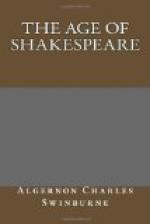to such plays as these as mixed and peculiar a quality
as though the playwright’s aim or ambition had
been to unite in his humble and homespun fashion the
two parts of an epic or patriotic historian and a
political or social caricaturist; a poet and a pamphleteer
on the same page, a chronicler and a jester in the
same breath. Of this Elizabethan chronicle the
first part is the more literal and prosaic in its
steady servility to actual record and registered fact:
the bitterest enemy of poetic or dramatic fiction,
from William Prynne to Thomas Carlyle, might well
exempt from his else omnivorous appetite of censure
so humble an example of such obsequious and unambitious
fidelity. Of fiction or imagination there is indeed
next to none. In Thomas Drue’s play of
“The Duchess of Suffolk,” formerly and
plausibly misattributed to Heywood, part of the same
ground is gone over in much the same fashion and to
much the same effect; but the subject, a single interlude
of the Marian persecution, has more unity of interest
than can be attained by any play running on the same
line as Heywood’s, from the opening to the close
of the most hideous episode in our history. That
the miserable life and reign of Mary Tudor should have
been “staged to the show” for the edification
and confirmation of her half-sister’s subjects
in Protestant and patriotic fidelity of animosity
toward Rome and Spain is less remarkable than that
the same hopelessly improper topic for historical
drama should in later days have been selected for
dramatic treatment by English writers and on one occasion
by a great English poet. As there are within the
range of any country’s history, authentic or
traditional, periods and characters in themselves
so naturally fit and proper for transfiguration by
poetry that the dramatist who should attempt to improve
on the truth—the actual or imaginary truth
accepted as fact with regard to them—would
probably if not certainly derogate from it, so are
there others which cannot be transfigured without
transformation. Such a character is the last and
wretchedest victim of a religious reaction which blasted
her kingdom with the hell-fire of reviving devil-worship,
and her name with the ineffaceable brand of an inseparable
and damning epithet. If even the genius of Tennyson
could not make the aspirations and the agonies of
Mary as acceptable or endurable from the dramatic or
poetic point of view as Marlowe and Shakespeare could
make the sufferings of such poor wretches as their
Edward II. and Richard II., it is hardly to be expected
that the humbler if more dramatic genius of Heywood
should have triumphed over the desperate obstacle
of a subject so drearily repulsive: but it is
curious that both should have attempted to tackle
the same hopeless task in the same fruitless fashion.
The “chronicle history” of Mary Tudor,
had Shakespeare’s self attempted it, could scarcely
have been other—if we may judge by our human
and fallible lights of the divine possibilities open




